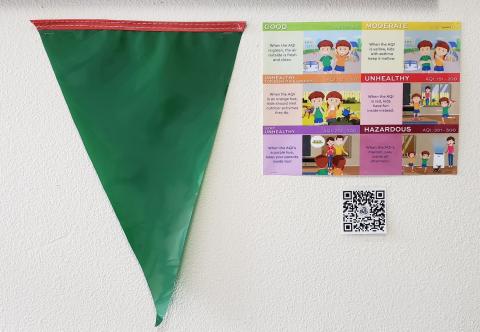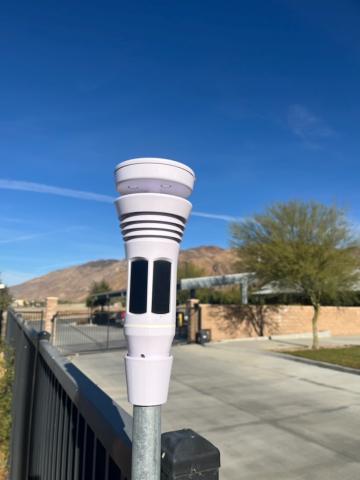The Soboba Tribal Environmental Department hosted a talking circle at Tribal Hall on Feb. 27 to discuss air quality, among other issues of importance to Tribal members. Environmental Specialist Loren Estrada, the newest member of the STED team, led the presentation that covered types and sources of indoor air pollution, how air pollution affects health and ways to reduce indoor air pollution.
“We are focusing on indoor air quality because there is not much we can do about outdoor ambient air quality,” Estrada said.
Common household air pollutants include combustion products such as tobacco smoke, carbon monoxide, nitrogen dioxide and particulate matter. Biological contaminants that are often found in homes are mold, dust mites, pollen, bacteria and viruses. Familiar chemical contaminants are pesticides, asbestos and lead. VOCs (volatile organic compounds) are a group of chemicals that evaporate into the air at room temperature and are a major cause of indoor air pollution. VOCs are found in many products, including paints, fuels, and cleaning products.
Estrada suggested using good ventilation when cleaning small areas as aromatic hydrocarbons can pose fleeting as well as long-term health risks. Children with developing lungs are a lot more susceptible to it.
“Asthma affects almost 12% of people living in Tribal communities, nearly double the national average of 7%,” she said. “Managing triggers is important for Tribal communities who are disproportionately affected by asthma.”
Estrada broke down how different pollutants can be found in different rooms within a house due to their needed source. Bedrooms with pillows, blankets, carpets, upholstered furniture and stuffed toys can easily harbor biological contaminants, while damp surfaces in bathrooms can be prone to mold.
Some of the health effects of indoor pollution are respiratory problems, allergic reactions, eye irritation, headaches, nausea and even some forms of cancer that can develop as a result of environmental factors. Many health conditions can be attributed to pollutants, which is why it is important to be protected from exposure as much as possible.
Ways to reduce indoor air pollution include avoiding smoking indoors, dusting and vacuuming regularly and properly adjusting and maintaining combustion appliances to control the sources.
Ventilation can be improved by opening windows and doors, operating window fans or air conditioning and using exhaust fans. During times of outdoor air pollution, it is recommended to close windows and doors and use air cleaners and filtration systems to maximize effectiveness.
Estrada explained that effectiveness depends on how well it collects pollutants from indoor air (percentage efficiency rate) and how much air it draws through the filtering element (cubic feet per minute). She added that under ideal conditions, air cleaners can provide up to 90% reduction in indoor air pollution.
To help the talking circle participants get a head start on improving their home’s air quality, she led a do-it-yourself air purifier activity. The project involved attaching a square air filter to the back of a portable box fan so that it would instantly filter indoor air when the fan is turned on. Allowing it to be taken to various rooms within the house increases its ability to filter the air in the most offensive rooms, whether it be in the kitchen while cooking or in the living room while the fireplace is going.
“A typical 20-inch box fan can move about 1,500 to 2,000 cubic feet of air per minute depending on the model and speed settings,” Estrada explained. “In one hour, it would move 90,000 cubic feet. Using it in smaller settings of 300-1,000 sq. ft. is more realistic and more beneficial.”
Estrada began working at STED several months ago. A graduate of UC, Davis with a degree in Environmental Science focusing on Natural Resource Management, she previously worked for an air quality regulatory agency in Northern California. She is excited to bring her knowledge to Soboba to expand the air quality monitoring program.
“I am interested in reducing major smoke event impacts to the community through education, monitoring and fuels management,” Estrada said. “Compared to positions I’ve had in the past, being an Environmental Specialist for Soboba has made me realize just how interconnected major environmental threats are, especially in Indian Country where the resources to address them aren’t always readily available. For example, the way our changing climate influences the amount of rain we get in a year, which then influences the health of native vegetation, which affects the stability of our hillsides and streambeds, which comes back to affect local air quality, which I know in the long term, contributes to climate change. It’s a very real-world application of the positive feedback loop I learned about in school, and it requires us as staff to be both creative and persistent in addressing these issues in the interest of preserving the natural resources of the Reservation.”
She also introduced participants to an app that tracks fires and wind conditions to help residents see if they can expect to be impacted by smoke from wildfires, no matter their location. For more information, https://app.watchduty.org.
Tribal member Rosemary Morillo said this discussion from STED was important to Soboba residents because with climate change the air isn’t as clean as it used to be.
“A growth in population means more homes and vehicles,” she said. “These days, there are just too many people; that’s the cause of the poor air quality.”
She recalled that in the 1960s when there were only about 200 people living on the Soboba Reservation, their wells produced the best drinking water in the area, and they enjoyed clean air. These days, the weather is drier and there isn’t a rainy season like there used to be in the past.
Environmental Assistant Christine Rodriguez recently visited the Soboba Tribal Preschool to teach the youngest Tribal members about air quality. She said that for the children, her presentation was geared towards showing them that different colored flags represent different levels of air pollution from good (green) to hazardous (maroon). Using this system, the children can see the flag color upon entering the building each morning where it is posted on the front lobby’s wall.
Utilizing the publication from the United States Environmental Protection Agency titled, “Why is Coco Red?” Rodriguez was able to engage the children with a story and follow-up coloring activity about how a chameleon named Coco and his friends learn about wildfire smoke and how it can affect air quality and health.
“Them being so young, I think it was just more fun for them to hear the story, color, and ask questions,” Rodriguez said. “The main point was to introduce them to the Air Quality Index and learn the colors, so hopefully as we expand our education on the topic, they will continue seeing it as they go through school and can help teach others about it. Youth are the future, and they will soon be the ones who will be educating others.”
Having the flags prominently displayed will help parents and teachers gain insight and help them decide whether to let the children play outside when it’s nice or keep them inside during bad air quality events. The main goal of this program is to bring awareness to daily levels of air pollution so people can make informed decisions. Data collected from sensors positioned throughout the Reservation provides the AQI levels that are posted on the https://sobobaair.com/data/aqi website.
Weather stations have been installed at three key locations and provide detailed information at any given time of day as well as future forecasting. This is just another way that the Soboba Tribal Environmental Department is keeping Tribal members informed and updated on issues that affect their homeland. Morillo said she would like to see STED host future conversations about off-road recreational vehicles that cause erosion to the Reservation’s hills.
For more information, https://epa.soboba-nsn.gov.
Photos courtesy of the Soboba Band of Luiseño Indians







